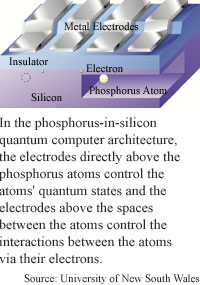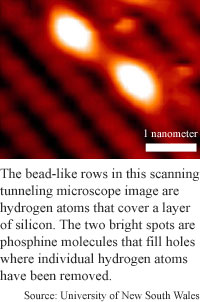
Positioned
atoms advance quantum chips
By
Eric Smalley,
Technology Research NewsA team of researchers at the University of New South Wales in Australia has laid the foundation for quantum computer chips that closely resemble today's mass-produced semiconductor chips. This is in sharp contrast to today's rudimentary prototype quantum computers, which are built out of complicated laboratory equipment.
The researchers have placed individual phosphorus atoms at regular intervals on a silicon surface. The work is the first step in implementing a silicon-based quantum computer architecture that uses phosphorus atoms embedded in silicon as quantum bits, or qubits.
"Our [research is] a demonstration of the controlled placement of single molecules on a semiconductor surface," said Jeremy O'Brien, a graduate student at the University of New South Wales.
This was challenging because individual phosphorus atoms readily bond to silicon, which makes it impossible to align phosphorus atoms by moving them around on a silicon surface. The researchers got around the problem by coating the silicon with a one-atom-thick layer of hydrogen and then using the probe tip of a scanning tunneling microscope to remove individual hydrogen atoms at regular intervals.
The researchers put phosphorus atoms into the holes left after removing the hydrogen atoms by exposing the hydrogen-coated silicon to phosphine gas. Phosphine gas molecules are composed of phosphorus and hydrogen atoms. The phosphine bonded to the silicon, one molecule to a hole.
This showed that "it is possible to fabricate an atomically precise linear array of single, phosphorus-bearing molecules on a silicon surface with the required dimensions for the fabrication of a silicon-based solid-state quantum computer," said O'Brien.
The researchers were able to position the phosphorus atoms at four-nanometer intervals, which is smaller than the 20-nanometer intervals required for the phosphorus-silicon architecture. A nanometer is about 10 hydrogen atoms long.
"One of the major drawbacks to the [phosphorus-silicon] scheme was [the need to] to position phosphorus atoms with atomic precision on a silicon crystal," said Jonathan P. Dowling, supervisor of the quantum computing technologies group at NASA's Jet Propulsion Laboratory. "This phosphine idea is really neat, somewhat miraculous, and appears as if it might really work," he said.
The next step in the process is to cover the phosphine molecules with another layer of silicon, said O'Brien. "This will require very high-quality crystal growth to avoid defects which could disrupt the operation of the quantum computer. We must ensure that the phosphorus qubits incorporate into the silicon crystal and remain in the ordered atomic array," he said.
Once the phosphorus atoms are sandwiched in silicon, the next challenge is linking them together and to the outside world. The phosphorus-silicon architecture calls for a metal electrical contact positioned above each atom on the top layer of silicon to control the quantum state of the atom and read the state to determine whether it represents a 1 or a 0. Another metal contact positioned between two atoms could control the quantum interactions between them, according to O'Brien.
Quantum computers would be much faster than ordinary computers at certain tasks like cracking secret codes and searching large databases. Many researchers in the field say quantum computers are not likely to be ready for practical use for at least 20 years.
O'Brien's research colleagues were Steven R. Schofield, Michelle Y. Simmons, Robert G. Clark, Andrew S. Dzurak, Neil J. Curson and N. S. McAlpine of the University of New South Wales in Australia, Bruce E. Kane of the University of Maryland, and Marilyn E. Hawley and Geoffrey W. Brown of Los Alamos National Laboratory. Their research has been accepted for publication in the journal Physical Review B. The research was funded by the Australian Research Counsel, the Australian Government, the National Security Agency and the Advanced Research and Development Activity.
Timeline: >20 years
Funding: Government
TRN Categories: Quantum Computing
Story Type: News
Related Elements: Technical paper, "Towards the fabrication of phosphorus qubits for a silicon quantum computer," posted on the Los Alamos National Laboratory archive at http://arXiv.org/abs/cond-mat/0104569
Advertisements:
August 1/8, 2001
Page One
Tool reads quantum bits
Study shows fiber has room to grow
Search tool builds encyclopedia
Positioned atoms advance quantum chips
Electron beam welds nanotubes


News:
Research News Roundup
Research Watch blog
Features:
View from the High Ground Q&A
How It Works
RSS Feeds:
News
Ad links:
Buy an ad link
| Advertisements:
|
 |
Ad links: Clear History
Buy an ad link
|
TRN
Newswire and Headline Feeds for Web sites
|
© Copyright Technology Research News, LLC 2000-2006. All rights reserved.